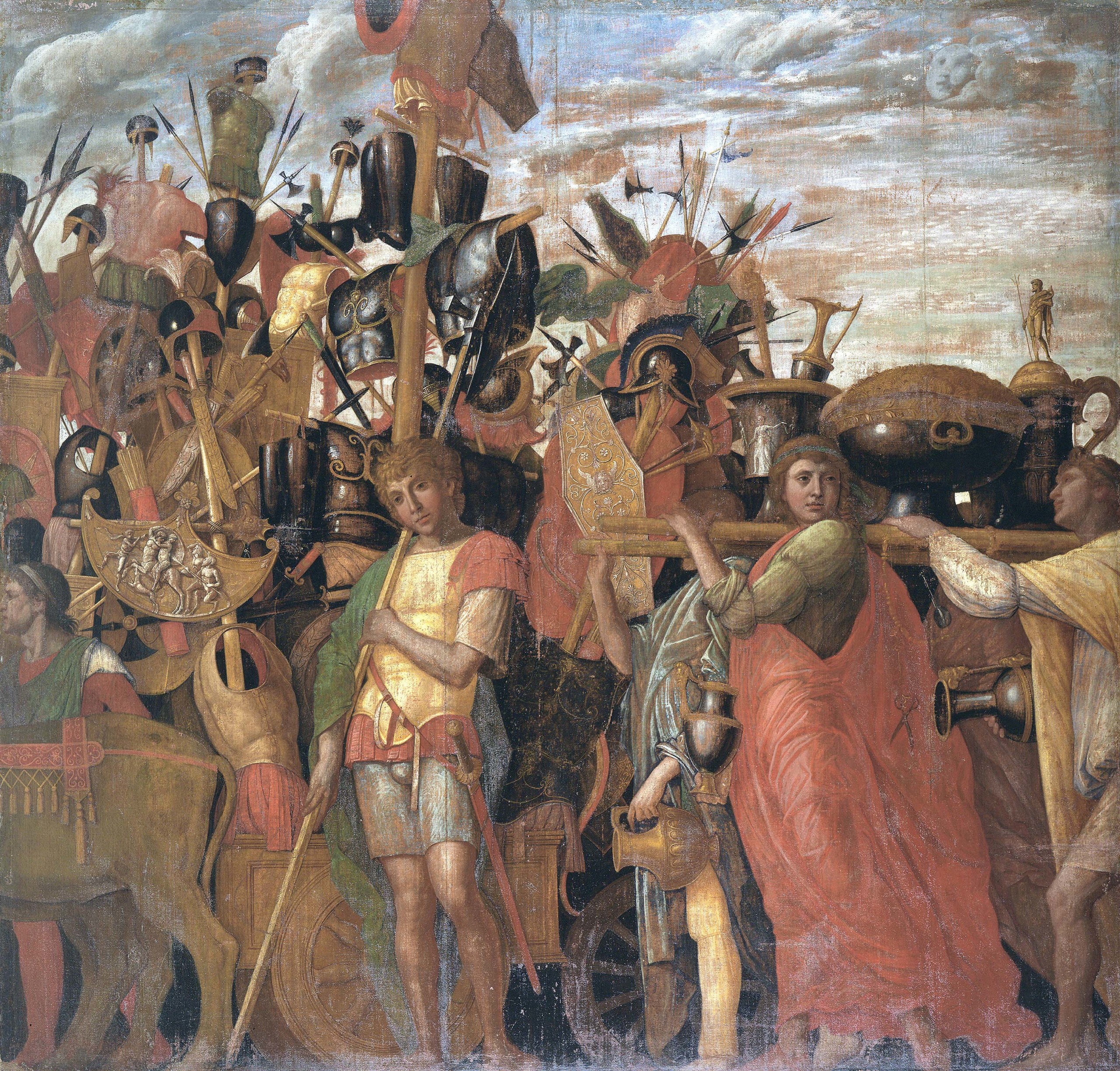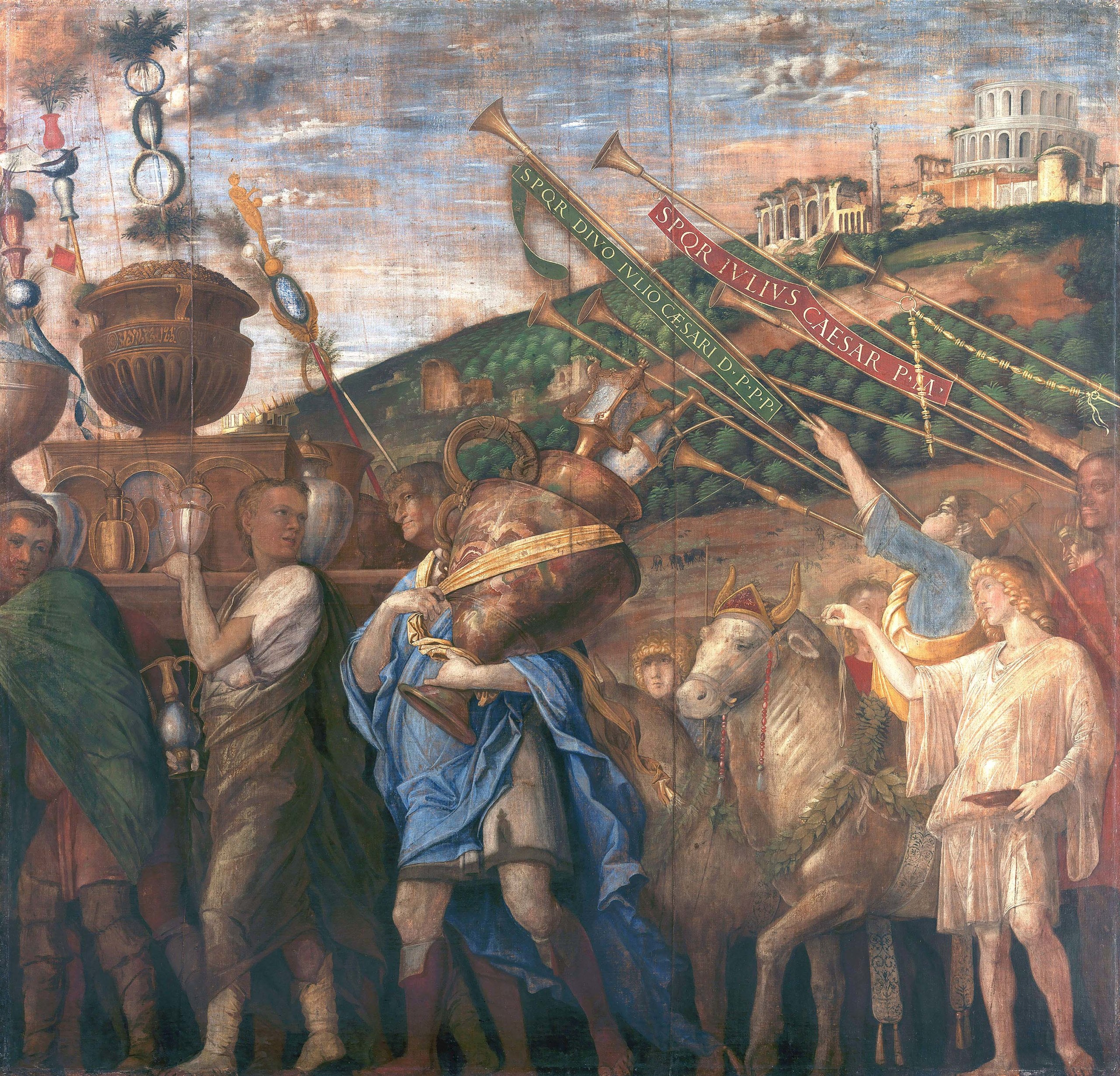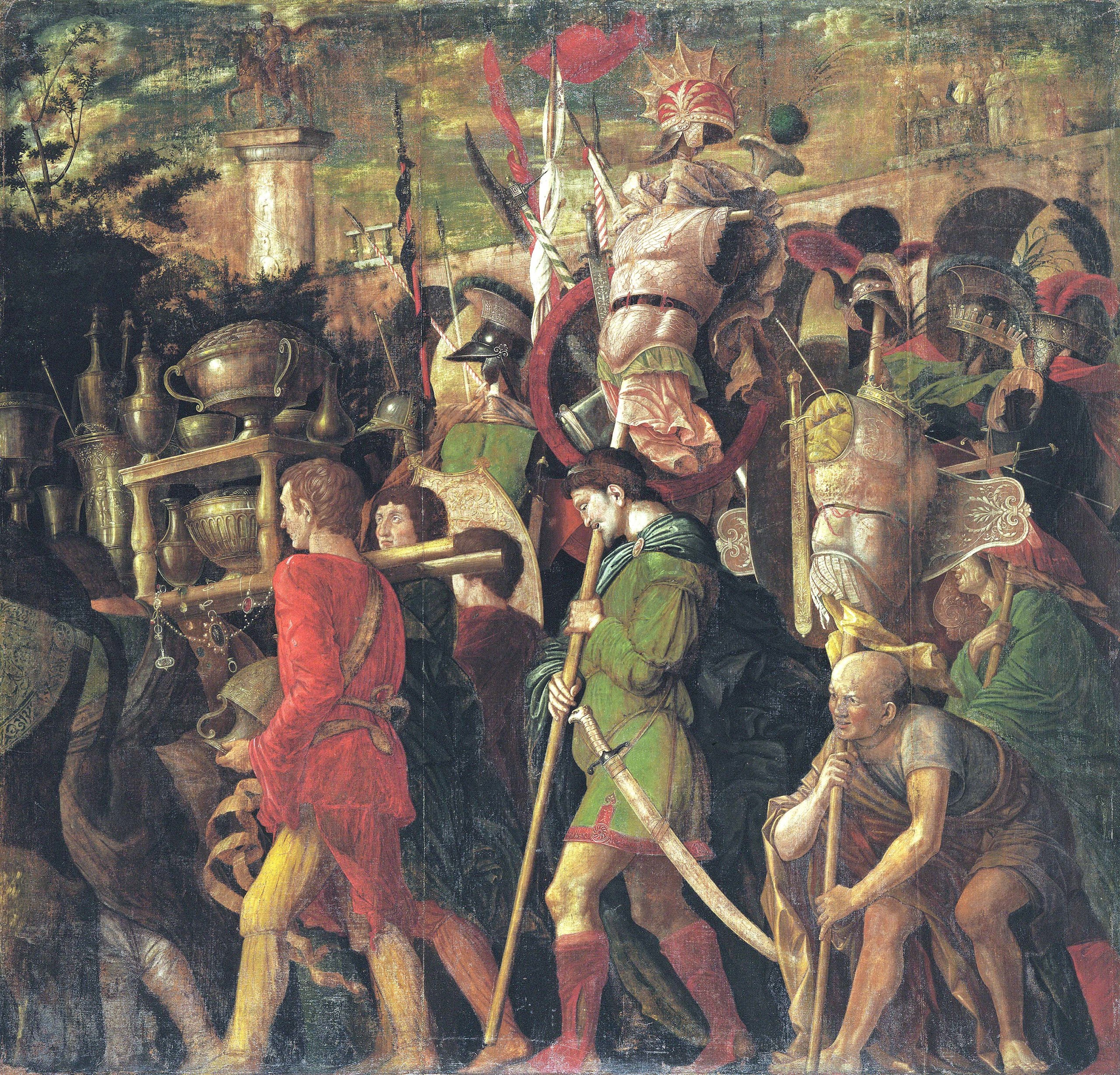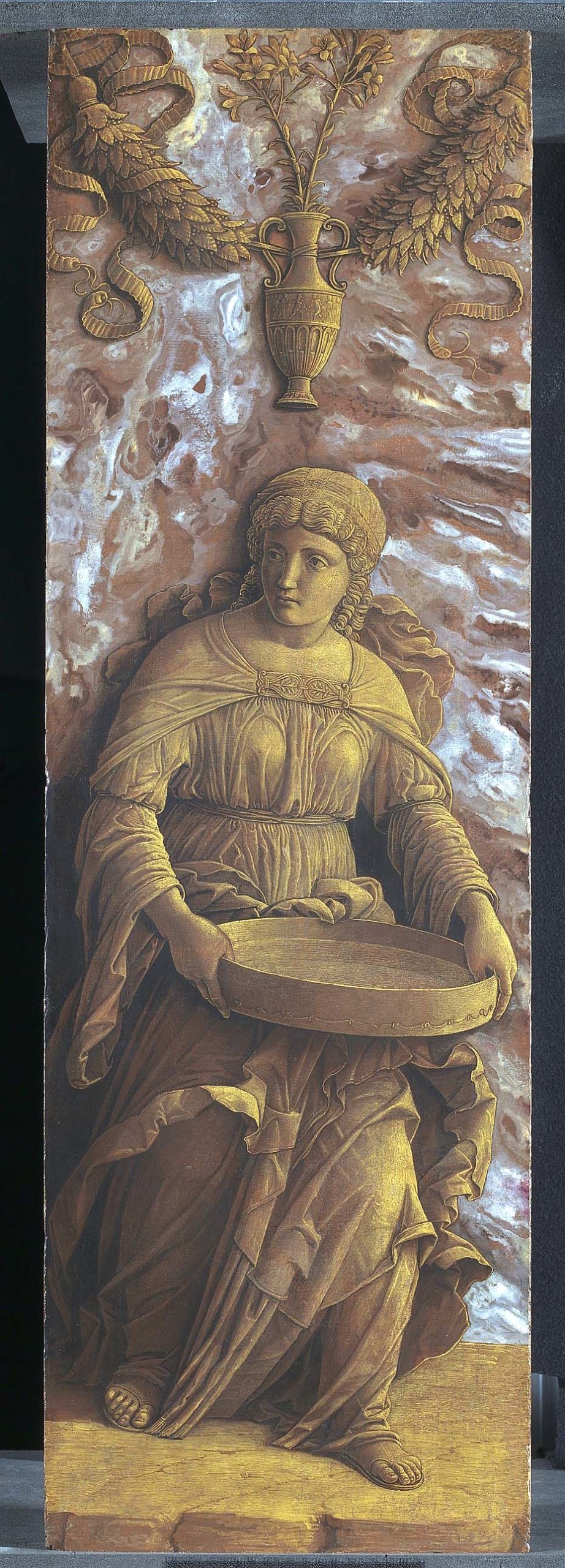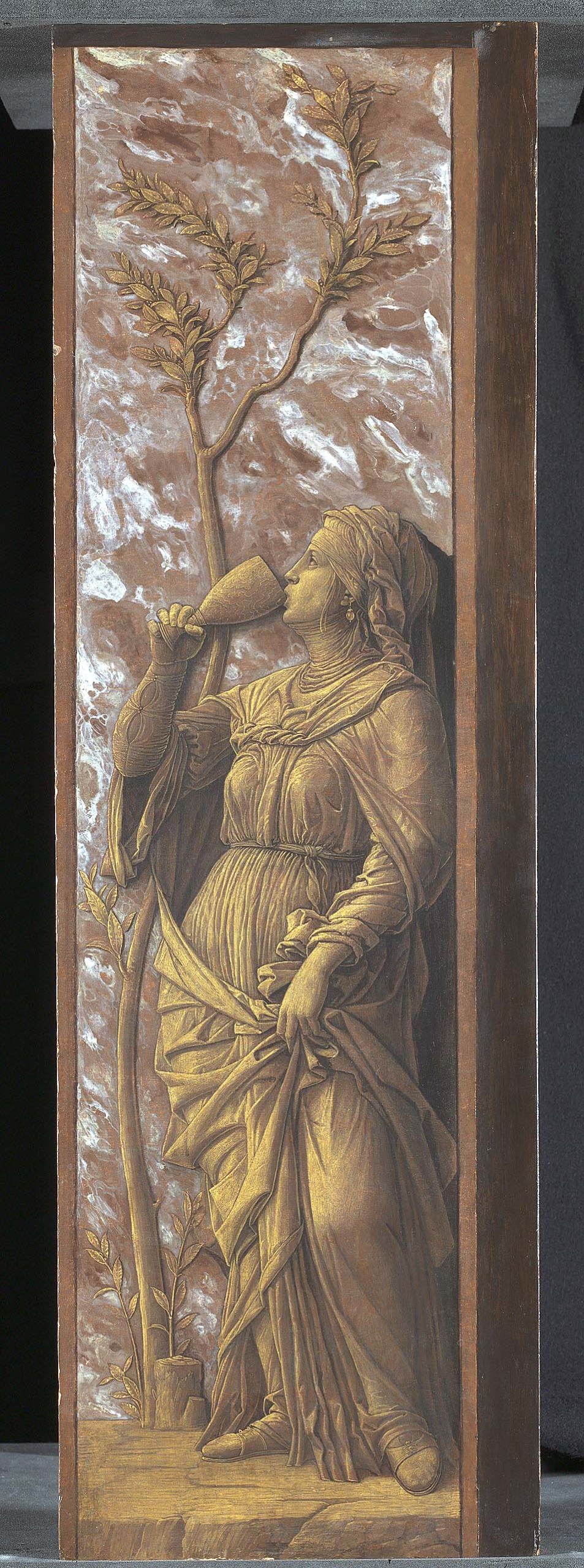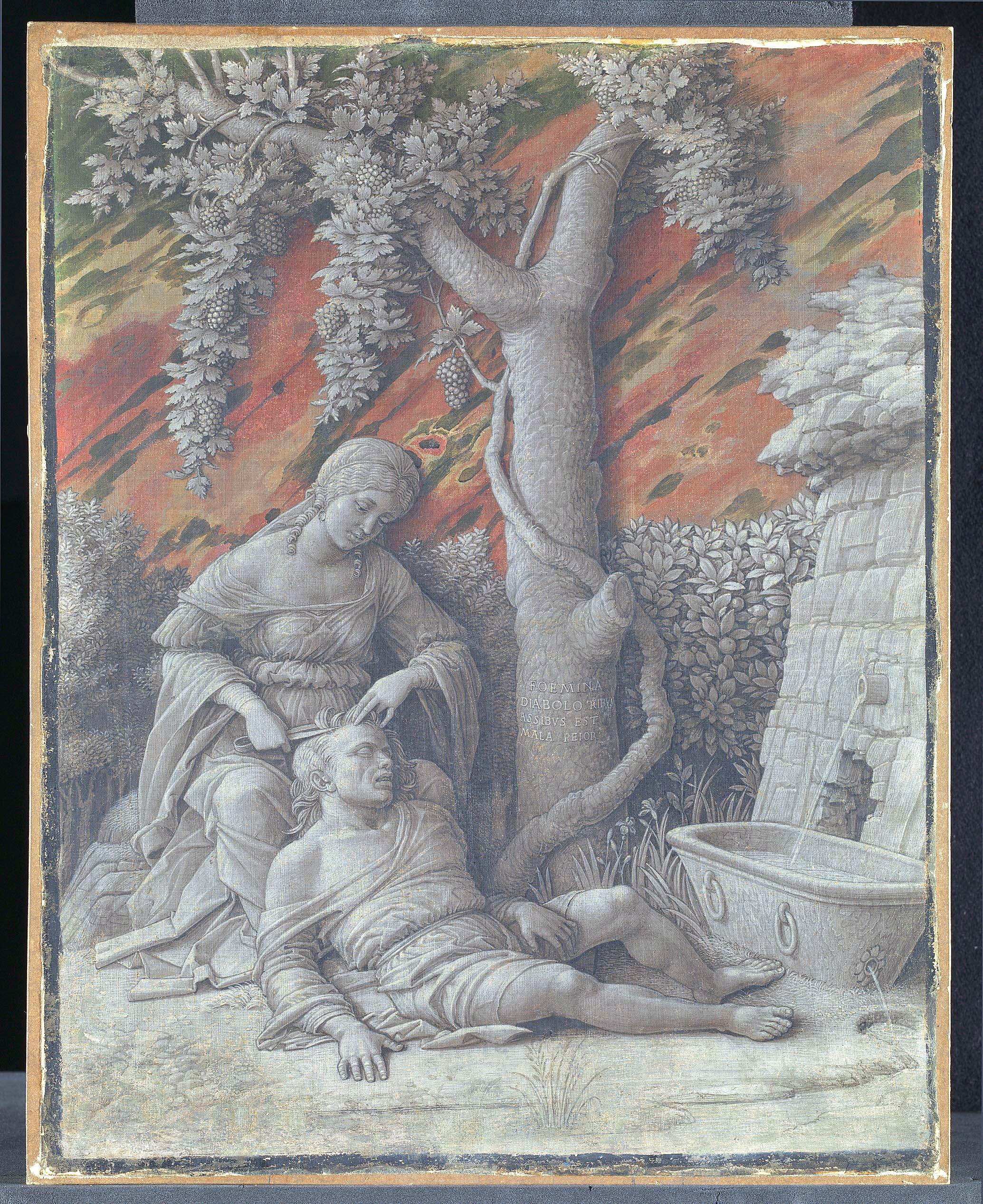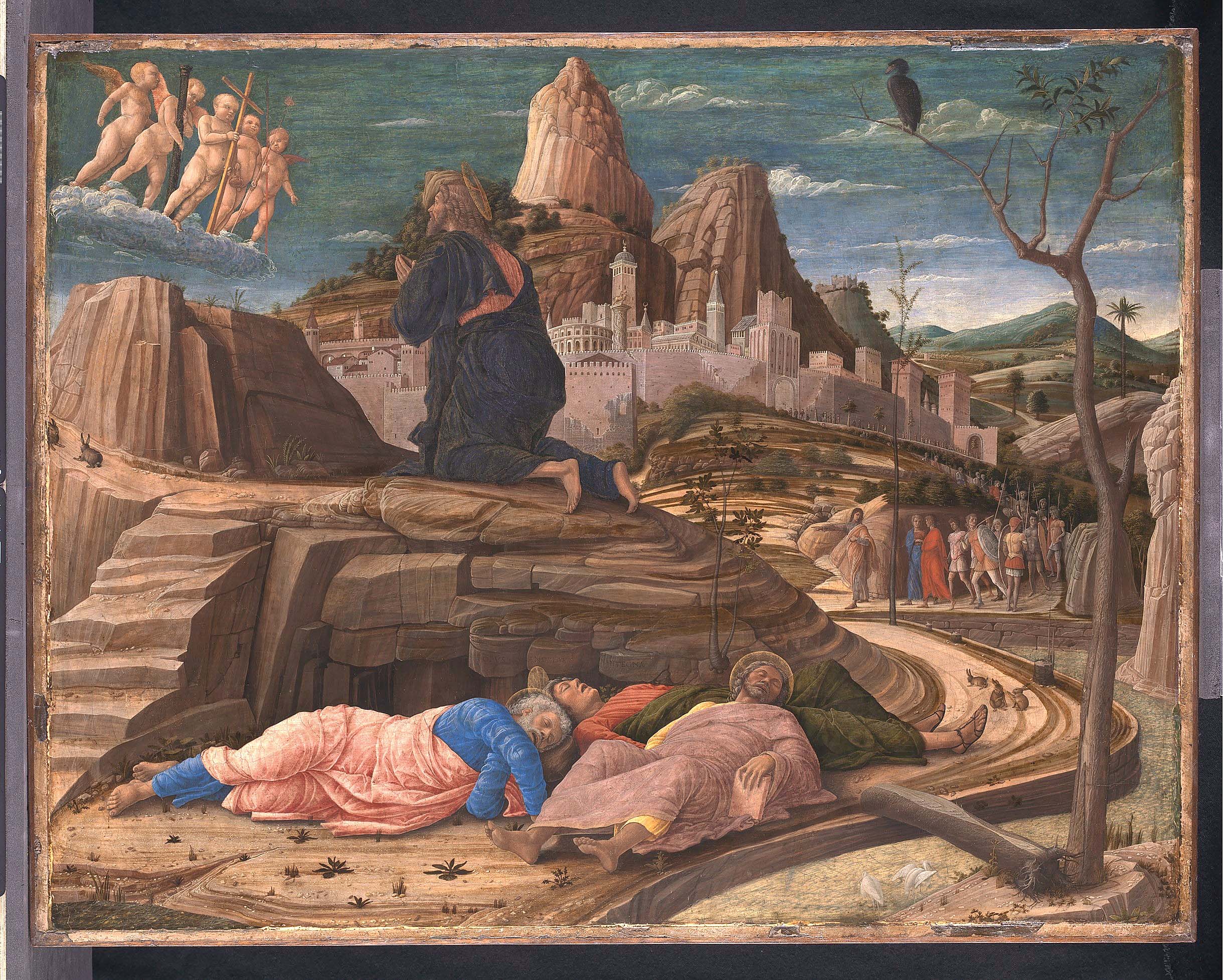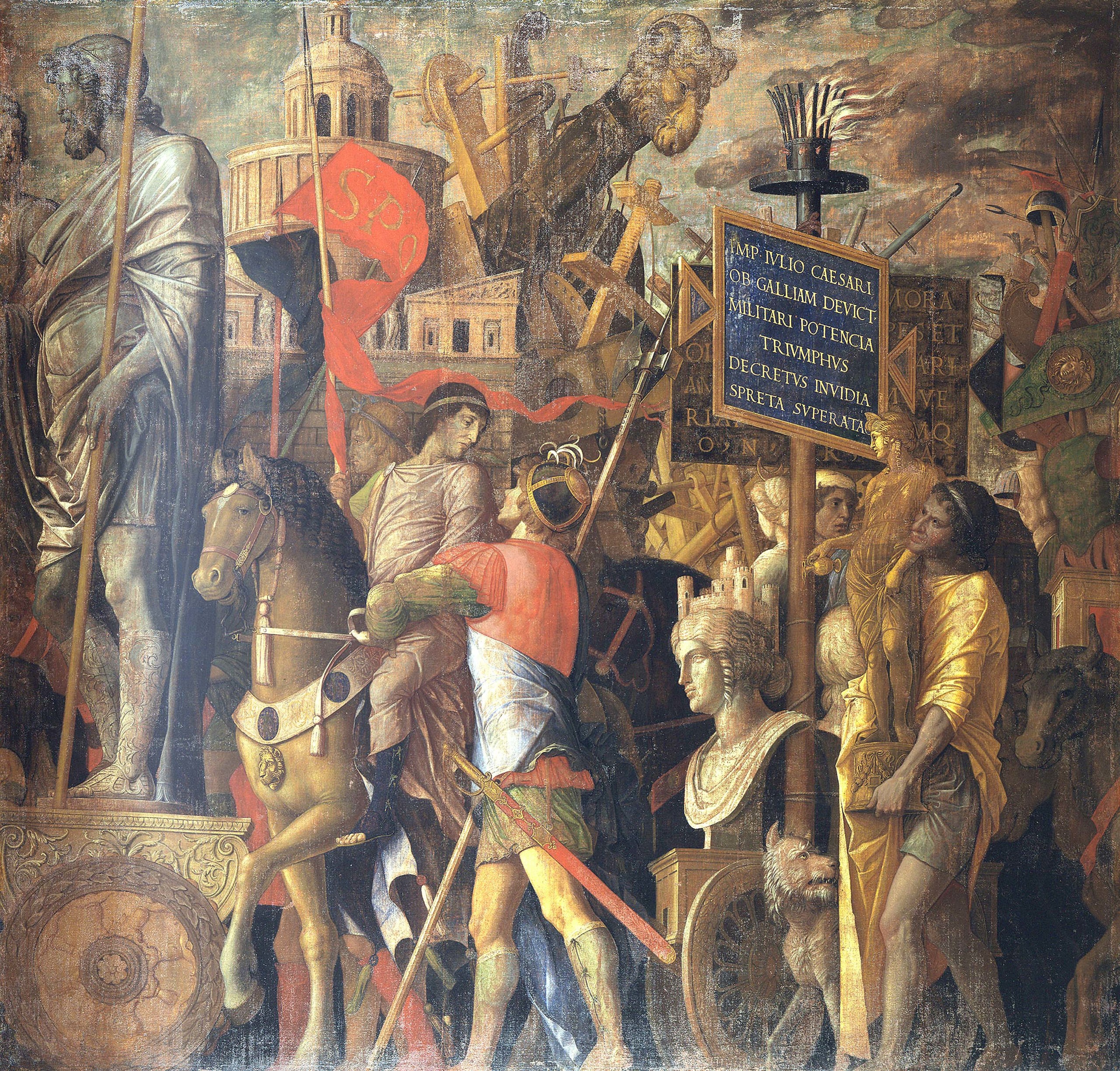
“The Triumphs of Caesar II: The Triumphal Carts” by Andrea Mantegna (about 1431-1506), mid-1480s before 1506, egg tempera on canvas, 106-3/8 by 110-5/8 inches. Royal Collection Trust / ©His Majesty King Charles III 2023. RCIN 403959.
By James D. Balestrieri
LONDON — Art outlasts empire. If — and when, that is — art survives empire.
It can’t be more than 100 or so yards from the Scrovegni Chapel in Padua — that we know as the Arena Chapel, decorated with Giotto’s (circa 1267-1337) frescos — to the ruins of the Overtari Chapel, whose decoration by Andrea Mantegna (circa 1431-1506) survives only in black and white photos taken before the Allies bombed it in World War II. Though I cannot and do not want to imagine bombs destroying either chapel, if I were compelled to choose between them, I suppose I would choose Giotto’s over Mantegna’s. But in order to accept this appalling, no-win situation, I would have to recite, over and over, eyes shut tight, in the voices of scholars from Vasari to Ruskin and beyond echoing in my ears, “The Renaissance begins with Giotto and the Arena Chapel.”
Giotto’s figures, drawn from life, exude humanity, liveliness, even a lifelikeness that marks a turn away from the deliberate anti-naturalism of Byzantine Art and other art forms of the Middle Ages. So I get it. Giotto is more important to the history of art — to history itself — than Mantegna. Yes, Mantegna is an important Renaissance painter and engraver. To get to Caravaggio and Bernini, you have to go through Mantegna. But Giotto was first. If fate were to spare one, Giotto’s Arena Chapel would be the right one. Still, as much as I recall Giotto’s frescoes, their gestures and colors — the pinks and mustard yellows stand out in memory — my most powerful recollection of that day is a feeling of an absence, an emptiness, of having missed out on something wonderful, Mantegna’s art as it once adorned the Overtari Chapel. And this is the point about Mantegna. He is a rare artist in that era because we almost know more about him than we do about his art. As a single example, we know that he sued his master Francesco Squarcione, successfully, for taking all the profits – and probably the credit – for his apprentice’s work. Yet we know next to nothing of the artworks Mantegna executed on Squarcione’s behalf.
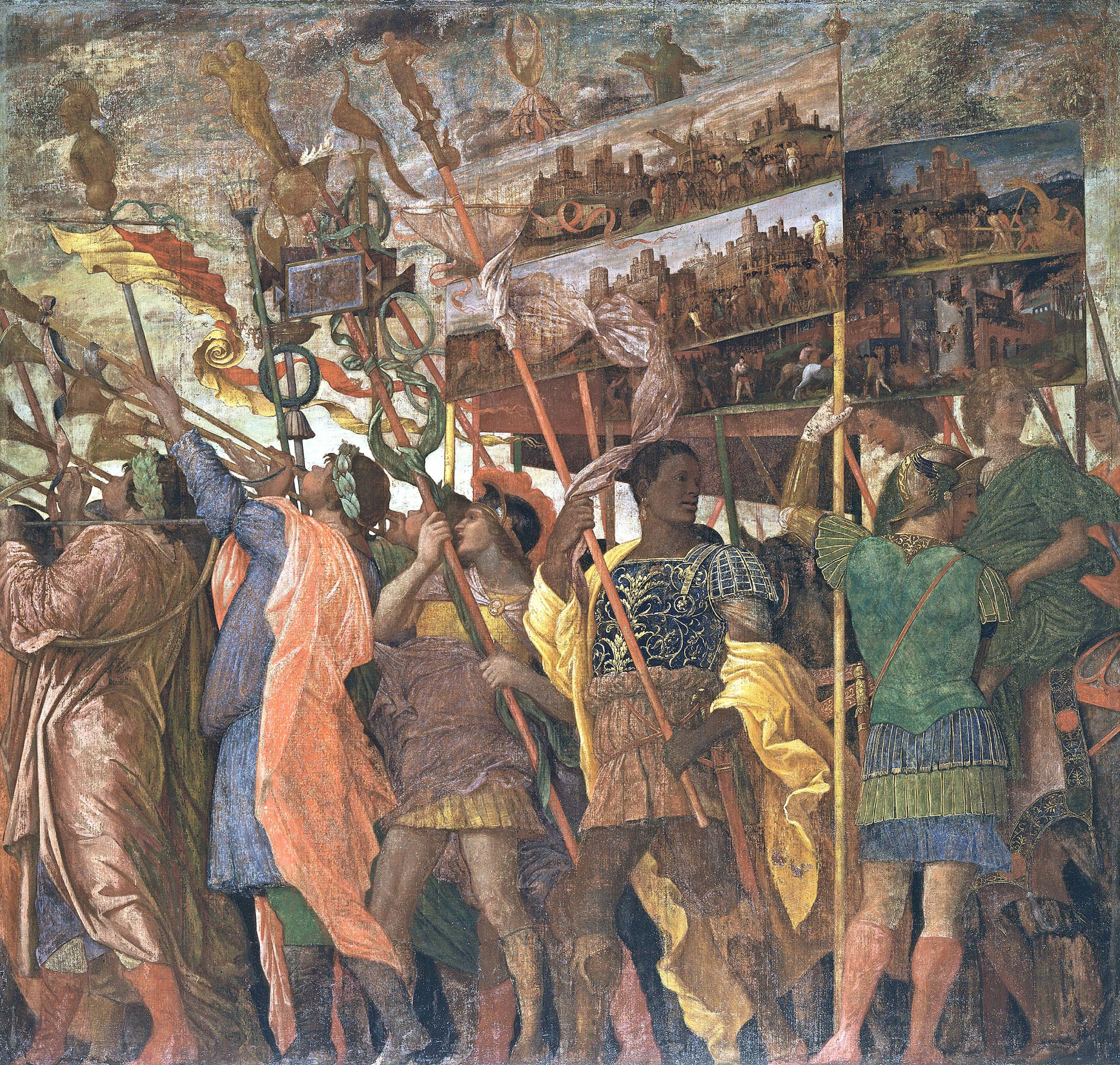
“The Triumphs of Caesar I: The Trumpeters” by Andrea Mantegna (about 1431-1506), mid-1480s before 1506, egg tempera on canvas, 106-3/8 by 110¼ inches. Royal Collection Trust / ©His Majesty King Charles III 2023. RCIN 403958.
This is why it is such a delight to find six of Mantegna’s nine magnificent canvases from his series, “The Triumphs of Caesar” now on view at London’s National Gallery, at least through 2025 while their permanent home at Hampton Court is renovated. As a bonus, the six hang in new frames that are more closely modeled after the originals.
Andrea Mantegna grew up in the university town of Padua at a time when the fervor for Roman antiquity crackled in the air. Though archaeology was not yet a formal science, Padua had plenty of Roman remains and her wealthy and educated citizens had a passion to excavate and study them alongside the many Latin and Greek texts that were in the process of being rediscovered, copied and disseminated (the printing press would greatly accelerate the broadcasting of this new “old” knowledge).
Mantegna left Padua for Mantua in 1460 to take up the mantle of court painter to Ludovico III Gonzaga (1412-1478), whose own classical education led to a program of urban transformation. Mantua would become a cultural capital on the Italian peninsula, and, as a result, Mantegna would meet visiting scholars and would have access to numerous archaeological sites as well as antiquities in the collections of the court.
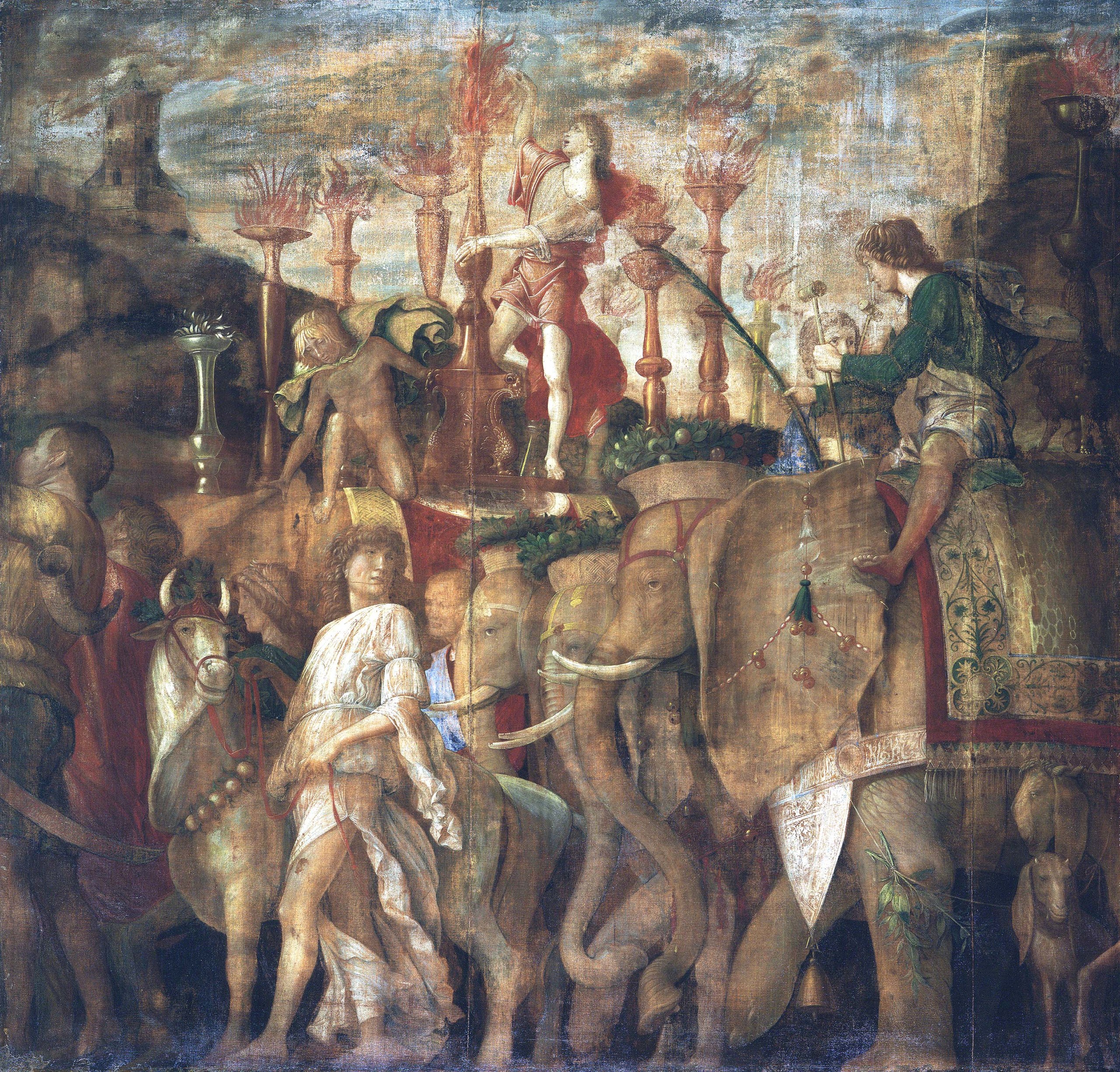
“The Triumphs of Caesar V: The Elephants” by Andrea Mantegna (about 1431-1506), mid-1480s before 1506, egg tempera on canvas, 106¼ by 110½ inches. Royal Collection Trust / ©His Majesty King Charles III 2023. RCIN 403962.
Drawing on classical sources, Mantegna worked on the “Triumphs of Caesar” from the mid-1480s until his death in 1506. Painted in imitation of Roman friezes, the canvas panels are an imagined rendering of a ritual procession celebrating Julius Caesar’s defeat of Gaul between 58-50 BCE and his victory over the Kingdom of Pontus in Asia Minor in 47 BCE — a victory so swift it gave rise to Plutarch’s famous epigraph, “Veni, Vidi, Vici” (“I came, I saw, I conquered.”). King Charles I acquired the nine canvases in 1629 and they were on display at the Hampton Court Palace until the king’s execution in 1649 when they were sold. Eventually, the crown reacquired the “Triumphs” and they remain among the jewels of Hampton Court. Despite having suffered damage and poor restoration over the centuries — one artist went so far as to repaint the Black standard bearer in “The Trumpeters” as a Caucasian man — the “Triumphs” continue to inhabit that rare artistic space between power and beauty. I used the word “delight” earlier, and while they are certainly that — a feast for the eye — they also inspire meditations on the nature and ephemerality of political power.
As text from the exhibition’s website states, the “‘Triumphs of Caesar’ had a lasting influence on European art. Their fame was immediate: admired at the Gonzaga court and praised by the artist and biographer Giorgio Vasari as ‘the best thing he [Mantegna] executed’…Throughout the centuries they inspired countless artists, including Hans Holbein the Younger, Peter Paul Rubens, and Edgar Degas.” Engravings and woodcuts after the “Triumphs” were extremely popular. One set even came with prints of pillars meant to divide the nine scenes so that it would appear as if the procession were going past a colonnade.
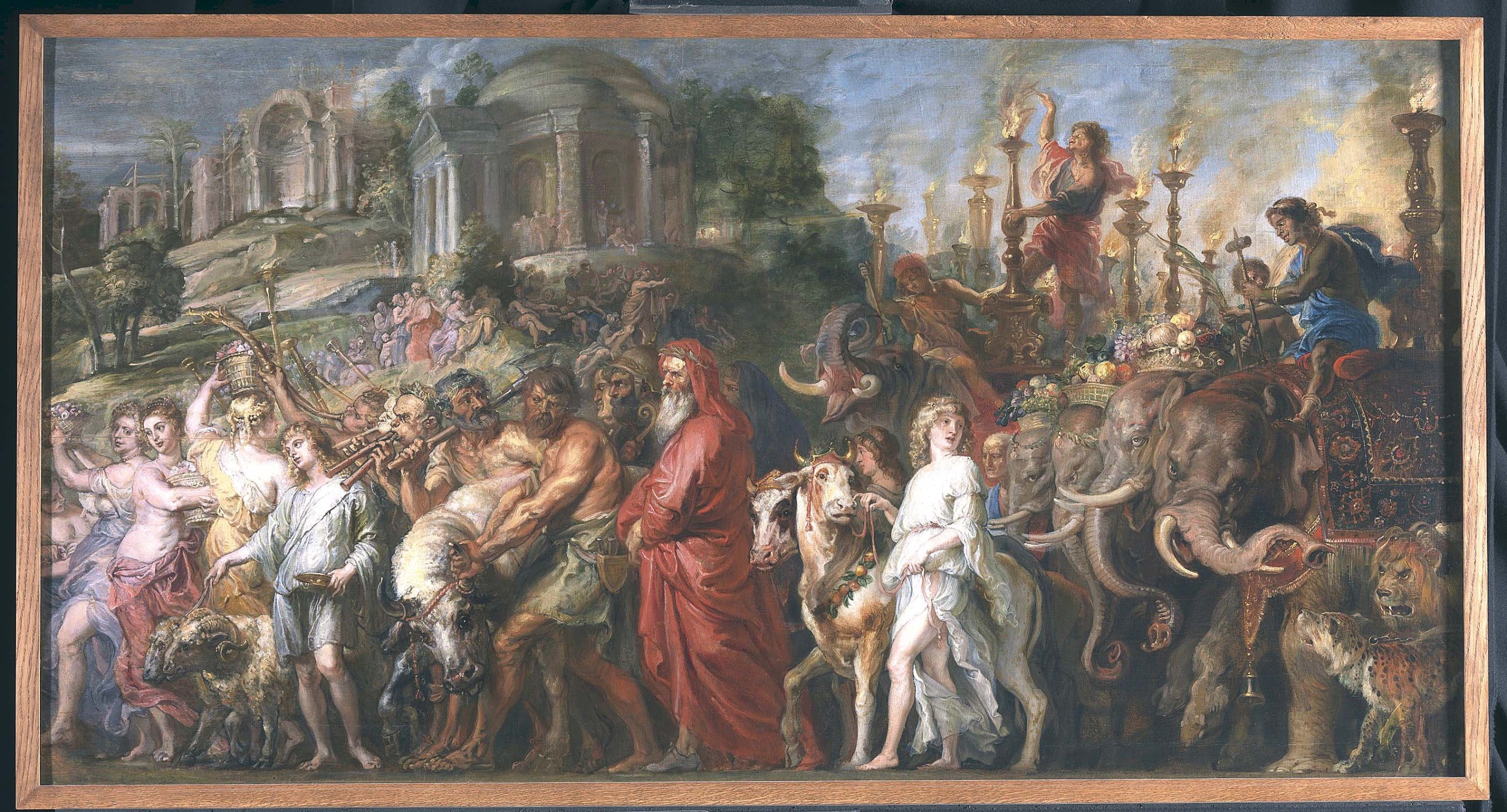
“A Roman Triumph,” by Peter Paul Rubens, about 1630. ©The National Gallery, London.
In a nod to the enduring inspiration of the “Triumphs,” Rubens’s “A Roman Triumph,” painted circa 1630, hangs alongside Mantegna’s canvases. A look at the Rubens painting, a superb example in its own right, beside any of Mantegna’s paintings, and a comparison of one single aspect — point of view — demonstrates Mantegna’s originality and painterly daring. Rubens places the viewer at a distance, taking in a good part of the triumph, and most of the elements in Mantegna’s paintings. Mantegna, on the other hand, places the viewer right up against the procession. You are to imagine yourself as a member of the crowd, the throng. As you are this close, with no bodies or heads to obscure your vision, you were one of the early ones, the ones these days who camp out for concert tickets — though the internet has rendered that somewhat quaint and obsolete. You can feel the press and jostle of people behind you. You can hear their cries of amazement. But you can’t look away from the spectacle. And indeed, it is a spectacle — political theater intended to project the power of a single person, Caesar, borne aloft at the end like Santa Claus at the end of the Macy’s Thanksgiving Parade, signaling the end of the procession, as if saying, “Go home. Get ready for a change in the weather.” You will have to venture to Hampton Court to see Mantegna’s “Caesar,” which is not on display at the National Gallery, but it seems a highly worthwhile journey to complete the picture.
Mantegna fills each frame. More than that, the bearers of painted pictures of the campaign and captured armor and art and braziers whose oily smoke you can almost smell, the carts whose wooden wheels you can hear, the trumpeters whose voluntaries deafen you — these all spill out over the edges of the canvases. Jonathan Jones, in his recent essay on the exhibition in The Guardian, wrote that Mantegna’s aim was to put himself into this distant time, a civilization that was, perhaps, better than his own, and that he — Mantegna — wanted “to hear the trumpets and smell the elephant dung.” He didn’t write “dung.” As far distant as Mantegna’s world was from Caesar’s, it is that much farther now, and yet, because Mantegna’s humanism puts, well, the human, front and center, the figures who — literally — bear the brunt and weight of Caesar’s triumph. They emerge from the canvases as individuals whose stories we take in at a glance and take with us once the parade passes by: the Black legionnaire in the magnificent filigreed cuirass; the litter bearer looking out into the crowd, perhaps at someone he knows, calling out his name; the bent back groom, veteran of many campaigns. What would they say if they could stop and answer our questions?

“The Introduction of the Cult of Cybele at Rome” by Andrea Mantegna, 1505-06. ©The National Gallery, London.
Deep in “The Triumphs of Caesar” sleeps the Fall of Rome. The appearance of fullness, of what one might call plenitude emerges from Mantegna’s study of shallow relief in ancient carving — consider “Introduction of the Cult of Cybele at Rome” or the matched pair, “A Woman Drinking” and “Vestal Virgin Tuccia with Sieve.” Look at these, think about their sources: ruins unearthed. Mantegna wants us to hear the footfalls of the elephants, the bray of trumpets, the clang of the empty armor and the cries of the crowd. He also wants us to hear the echoes of the pageant.
Mantegna’s “Triumphs of Caesar” have such presence that they almost supplant the absence created by the loss of the Overtari Chapel. Almost. Yet the “Triumphs” suggest losses of another kind — falls from greatness and power. Imagine, in some far-flung, unimaginable future, a future Mantegna inspired by the unearthing of the Washington Monument, then setting out to recreate, in whatever art is at that time, the notion of a lost, better past. And then imagine that artist, through art, wondering whether that past was really better, or any different at all and somehow communicating that even farther into the future. It gives me chills and leads me to think again about the dynastic families of the Italian Renaissance — the Medici, Sforzas, Borgias, Gonzagas and others — and their imperial ambitions. Apart from the inventive ways in which they dispatched one another and their enemies, what we remember them for is their patronage of the arts. Without them, no Da Vinci, no Michelangelo, no Raphael, no Mantegna.
I’ll amend the first sentence in this essay. Art outlasts empire. Period.
London’s National Gallery is at Trafalgar Square. For information, www.nationalgallery.org.uk.

